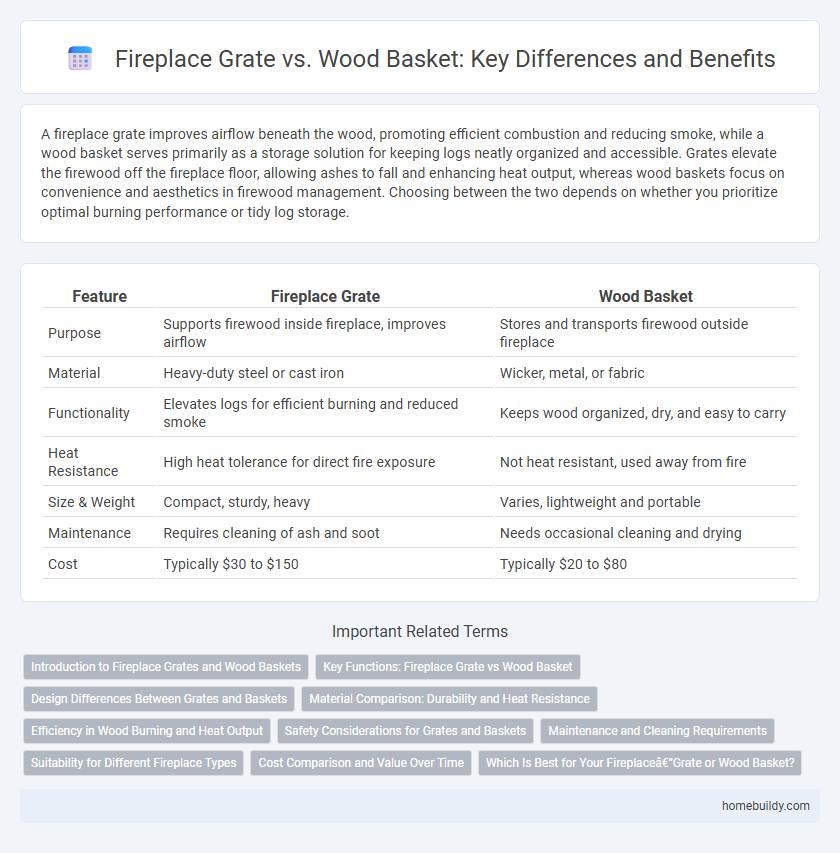A fireplace grate improves airflow beneath the wood, promoting efficient combustion and reducing smoke, while a wood basket serves primarily as a storage solution for keeping logs neatly organized and accessible. Grates elevate the firewood off the fireplace floor, allowing ashes to fall and enhancing heat output, whereas wood baskets focus on convenience and aesthetics in firewood management. Choosing between the two depends on whether you prioritize optimal burning performance or tidy log storage.
Table of Comparison
| Feature | Fireplace Grate | Wood Basket |
|---|---|---|
| Purpose | Supports firewood inside fireplace, improves airflow | Stores and transports firewood outside fireplace |
| Material | Heavy-duty steel or cast iron | Wicker, metal, or fabric |
| Functionality | Elevates logs for efficient burning and reduced smoke | Keeps wood organized, dry, and easy to carry |
| Heat Resistance | High heat tolerance for direct fire exposure | Not heat resistant, used away from fire |
| Size & Weight | Compact, sturdy, heavy | Varies, lightweight and portable |
| Maintenance | Requires cleaning of ash and soot | Needs occasional cleaning and drying |
| Cost | Typically $30 to $150 | Typically $20 to $80 |
Introduction to Fireplace Grates and Wood Baskets
Fireplace grates are metal frameworks designed to hold burning logs securely in the center of a fireplace for optimal airflow and efficient combustion. Wood baskets serve as storage containers that organize and protect firewood, keeping it dry and accessible near the hearth. While grates improve fire performance, wood baskets enhance convenience and safety by managing wood supply.
Key Functions: Fireplace Grate vs Wood Basket
A fireplace grate elevates logs to improve air circulation and efficient combustion, enhancing heat output and reducing smoke buildup. In contrast, a wood basket serves primarily for storage and transport of firewood, keeping logs organized and easily accessible without affecting the burning process. Choosing between a fireplace grate and a wood basket depends on whether the priority is optimizing fire performance or managing wood storage.
Design Differences Between Grates and Baskets
Fireplace grates feature elevated metal bars designed to hold and elevate burning logs, allowing optimal airflow for efficient combustion and ash collection beneath. Wood baskets prioritize storage and transport of logs, often crafted from wicker or wrought iron with a more open, basket-like structure emphasizing capacity and portability over heat resistance. The design differences reflect their distinct functions: grates optimize fire performance, while baskets focus on convenient wood storage and accessibility.
Material Comparison: Durability and Heat Resistance
Fireplace grates are typically made from heavy-duty cast iron or steel, providing excellent durability and superior heat resistance essential for withstanding prolonged high temperatures. In contrast, wood baskets often use lighter materials such as wicker, metal mesh, or thin steel, which offer less heat resistance and may degrade faster when exposed to intense heat. The robust construction of fireplace grates ensures a longer lifespan and better performance during wood combustion compared to the more decorative and less heat-resistant wood baskets.
Efficiency in Wood Burning and Heat Output
A fireplace grate enhances wood burning efficiency by improving airflow and allowing wood to burn more completely, resulting in higher heat output. In contrast, a wood basket primarily serves as storage and does not impact combustion efficiency or heat production. Using a fireplace grate can reduce smoke and increase the amount of usable heat generated from the same amount of wood.
Safety Considerations for Grates and Baskets
Fireplace grates provide better airflow and burn efficiency while securely holding logs above the hearth, reducing the risk of embers falling onto the floor. Wood baskets, typically made from woven materials, offer a convenient storage solution but lack the heat resistance and containment needed during active fires. For enhanced safety, metal fireplace grates are preferred to prevent accidental fires and ensure proper ventilation during combustion.
Maintenance and Cleaning Requirements
A fireplace grate requires regular removal of ash and debris to maintain airflow and prevent rust, often needing a wire brush for thorough cleaning. In contrast, a wood basket demands minimal cleaning, primarily just occasional dusting since it only stores wood outside the fire. Both items benefit from keeping dry to extend lifespan, but the grate's constant exposure to heat and ash makes its maintenance more frequent and intensive.
Suitability for Different Fireplace Types
Fireplace grates are specifically designed to elevate wood for improved airflow and combustion, making them ideal for traditional masonry fireplaces. Wood baskets, on the other hand, are more suitable for storing and transporting wood rather than direct use inside the firebox, especially in smaller or enclosed fireplaces like wood stoves. Choosing between a fireplace grate and wood basket depends on the fireplace type, with grates enhancing burning efficiency in open hearths and baskets serving as convenient storage solutions outside the fire.
Cost Comparison and Value Over Time
Fireplace grates typically cost between $30 and $100, offering durable steel construction that withstands high heat and prolongs firewood life, making them a cost-effective option over time. Wood baskets range from $40 to $120, with designs focused on aesthetic appeal and portability but may wear faster due to lighter materials. Choosing a fireplace grate provides greater value over time through enhanced combustion efficiency and reduced wood waste.
Which Is Best for Your Fireplace—Grate or Wood Basket?
A fireplace grate enhances airflow and combustion by elevating the firewood, resulting in hotter and more efficient burns compared to a wood basket, which primarily serves as a storage solution for logs. While a wood basket offers convenience and aesthetic appeal by neatly organizing firewood beside the fireplace, it does not contribute to the burning process itself. Choosing between a fireplace grate and a wood basket depends on whether your priority is improved fire performance or practical wood storage.
Fireplace grate vs Wood basket Infographic

 homebuildy.com
homebuildy.com